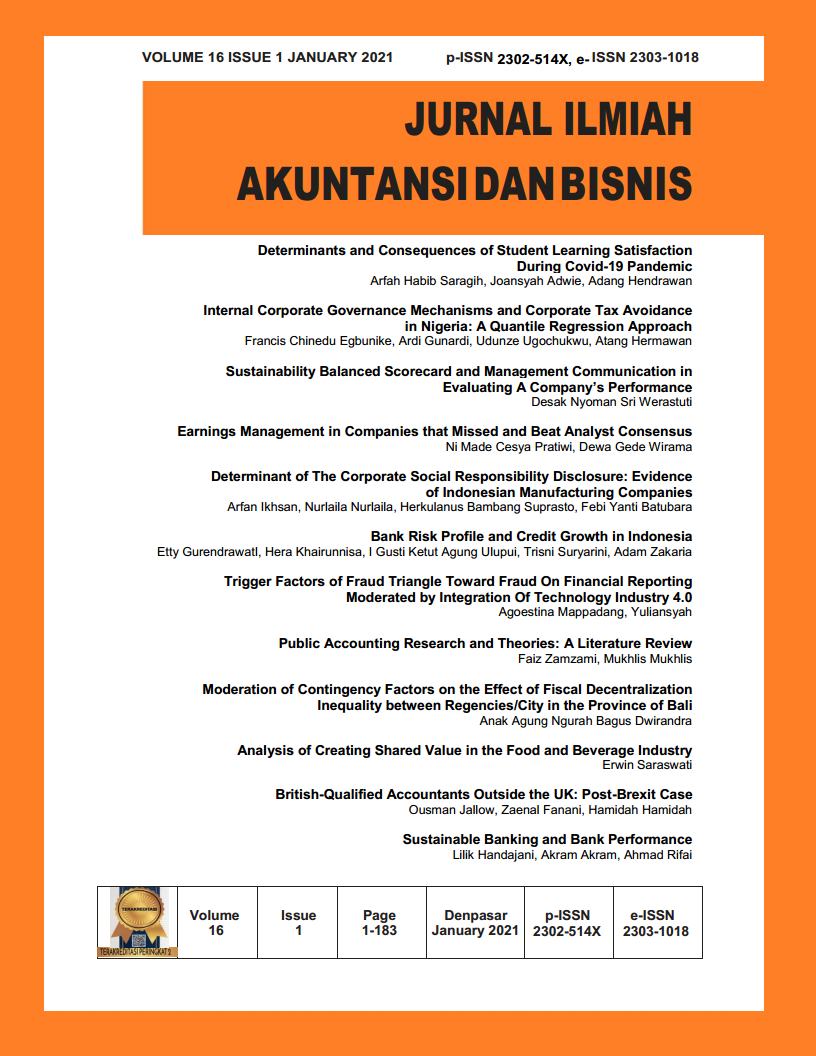Sustainable Banking and Bank Performance
Abstract
This research aims to examine the impact of sustainable banking practices and bank characteristics on bank performance. Structural equation models were used to analyze 11 banks listed on the Indonesia Stock Exchange that published sustainability reports consistently during the periods of 2015–2018. Results indicate that while the internalization of sustainability issues in banking business practices does not have a significant impact on bank performance, the characteristics of a bank, which are reflected by institutional and foreign ownership and bank age, have a significant effect on bank financial and nonfinancial performance. The implications of sustainable banking practices are indicated to gain legitimacy from regulators for the existence of financial entities and meet stakeholder expectations, which in practice require trade-off of interests among stakeholder groups.
Keywords: sustainable banking, bank performance, bank characteristic
Downloads
References
Aggarwal, P. (2013). Impact of sustainability performance of company on its financial performance: A study of listed Indian companies. Global Journal of Management and Business Research Finance, 13(11), 61–70.
Akter, N., Siddik, A. B., & Mondal, M. S. Al. (2017). Sustainability reporting on green financing : A study of listed private sustainability. Journal of Business and Technology, XII(July-December), 14–27.
Alshehri, A. F. (2016). An xxamination of the relationship between size, age and financial performance in Islamic banks : Evidence from around the world. Journal of Islamic Economics Banking and Finance, 12(4), 155–178. https://doi.org/10.12816/0050984
Awino, O. (2014). the Relationship Between Green Banking and Financial Performance of Commercial Banks in Kenya. university of Nairobi.
Elston, J. (2002). An examination of the relationship between firm size, growth and liquidity in the Neuer Markt. Bundesbank Series 1 Discussion Paper, (2002).
Hair, J. F., Hult, G. T. m., Ringle, C. M., & Sarstedt, M. (2014). A Primer on Partial Least Squares Structural Equation Modeling (PLS-SEM) (Vol. 46). california: Sage Publications. https://doi.org/10.1016/j.lrp.2013.01.002
Handajani, L. (2019). Corporate governance dan green banking disclosure: Studi pada bank di Indonesia. Jurnal Dinamika Akuntansi Dan Bisnis, 6(2), 121–136. https://doi.org/10.24815/jdab.v6i2.12243
Handajani, L., Rifai, A., & Husnan, L. H. (2019). Kajian tentang inisiasi praktik green banking pada bank BUMN. Jurnal Economia, 15(1), 1–16. Retrieved from https://journal.uny.ac.id/index.php/economia
Haryati, N., Burhany, D. I., & Suhartanto, D. (2019). Assessing the profitability of Islamic banks: The role of bank age and bank performance. IOP Conference Series: Materials Science and Engineering, 662(6). https://doi.org/10.1088/1757-899X/662/6/062014
Hossain, S., & Kalince, T. A. (2014). Green Banking Nexus Banks’ Performance. Swiss Journal of Research in Business and Social Science, 1(3), 1–16. Retrieved from http://www.sjrbss.com/current-issue
Iqbal, M., Suviitawat, A., Nisha, N., & Rifat, A. (2016). The role of commercial banks in green banking adoption: a Bangladesh perspective. International Journal of Green Economics, 10(3/4), 226. https://doi.org/10.1504/ijge.2016.10002862
Islam, M. T., Kokubu, K., & Nishitani, K. (2020). Corporate social reporting in the banking industry of Bangladesh: a test of legitimacy theory. Social Responsibility Journal. https://doi.org/10.1108/SRJ-05-2019-0185
Jiang, C., Yao, S., & Feng, G. (2013). Bank ownership, privatization , and performance : Evidence from a transition country. 44, 1–36.
Rebai, S., Azaiez, M. N., & Saidane, D. (2012). Sustainable performance evaluation of banks using a multi-attribute utility model: An application to French banks. Procedia Economics and Finance, 2(March 2014), 363–372. https://doi.org/10.1016/s2212-5671(12)00098-6
Regehr, K., & Sengupta, R. (2016). Has the relationship between bank size and profitability changed? Economic Review, (Q II), 49–72.
Roy, M. K., Sarker, M. A. S., & Parvez, S. (2015). Sustainability in Banking Industry : Which way to move ? ASA University Review, 9(2), 53–69.
Saghi-Zedek, N. (2016). Product diversification and bank performance: Does ownership structure matter? Journal of Banking and Finance, 71, 154–167. https://doi.org/10.1016/j.jbankfin.2016.05.003
Scholtens, B., & Klooster, S. (2019). Sustainability and bank risk. Palgrave Communications, 5(105), 1–8. https://doi.org/10.1057/s41599-019-0315-9
Shah, A. A., Wu, D., & Korotkov, V. (2019). Are sustainable banks efficient and productive? A data envelopment analysis and the Malmquist productivity index analysis. Sustainability (Switzerland), 11(8), 1–19. https://doi.org/10.3390/su11082398
Shaumya, S., & Arulrajah, A. (2017). The Impact of Green Banking Practices on Bank’s Environmental Performance: Evidence from Sri Lanka. Journal of Finance and Bank Management, 5(1), 77–90. https://doi.org/10.15640/jfbm.v5n1a7
Simpson, W. G., & Kohers, T. (2002). 2002-The_Link_Between_Corporate_Social_and_Financial_Performance_Evidence_from_the_Banking_Industry. Journal of Business Ethics, 35(2), 97–109.
Usenko, L., & Zenkina, I. (2016). Modern Trends and Issues of Corporate Reporting Data Disclosure on Organization Activities. Mediterranean Journal of Social Sciences, 7(3), 212–220. https://doi.org/10.5901/mjss.2016.v7n3p212
Zimmermann, S. (2019). Same same but different: How and why banks approach sustainability. Sustainability (Switzerland), 11(8), 1–20. https://doi.org/10.3390/su11082267
Zyadat, A. A. H. (2016). The impact of sustainability on the financial performance of Jordanian Islamic Banks. International Journal of Economics and Finance, 9(1), 55. https://doi.org/10.5539/ijef.v9n1p55




















